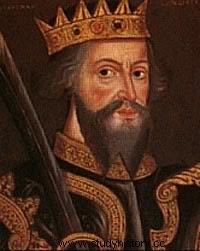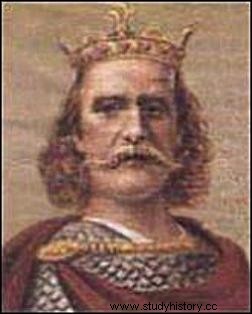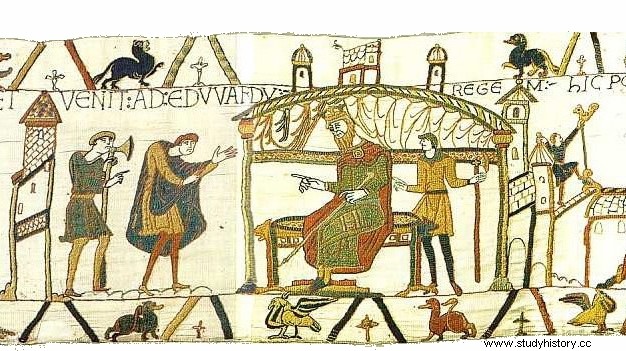On the occasion of the 950th anniversary of the Battle of Hastings, I return to the decisive events that culminated in the Norman conquest of England after that battle, which I discussed in the entries dedicated to the year 1066, Emma of Normandy, the coronation of William the Conqueror, Edgar Aetheling and Sweyn Forkbeard.
In today's post I am going to focus on a very specific event that apparently occurred two years before their confrontation at Hastings between the Saxon King Harold Godwinson and Duke William from Normandy. Let us remember that in that battle both contended to succeed the late monarch Edward The Confessor. as King of England. It is not the purpose of this article to delve into this issue; suffice it to say that Harold based his right on being chosen by the witan or Saxon council. William was Edward's maternal cousin and nephew of the twice queen, Emma of Normandy.
According to various chroniclers, on a journey to the continent that Harold made a few years earlier (most sources date it to 1064), the Saxon arrived in Normandy and there swore the oath of obedience to William as successor to the English throne when Edward's death occurred. However, this fact (which William would use repeatedly as one more argument for his invasion of England) clashed head-on with Harold's aspirations to the English throne and, above all, with his previous and subsequent events, which in no way hinted that he had any intention to cede the crown to the Norman.
-

- William the Conqueror
Harold's oath to William as Edward's successor would legitimize Edward's invasion and his accession to the English throne. The mystery has been the subject of many theories throughout history:did Harold Godwinson swear allegiance to William of Normandy as the future king of England? And if he did, what was the reason?
The formidable Bayeux Tapestry tells how Harold, after paying a visit to King Edward The Confessor, embarked for the mainland. But his fleet fell victim to a severe storm and the Saxon almost miraculously managed to reach Ponthieu, a county between Flanders and Normandy. That was not the destination intended by Harold, because when he reached the coast he was captured by the ruler of the place, Count Guy, who took him prisoner to demand a ransom for him and his companions.
Always according to the Bayeux Tapestry, when William of Normandy becomes aware of this fact, he demands Guy to free the Saxons. It is not known whether out of fear or in exchange for money, but the fact is that the count frees Harold and his retinue, who are escorted by the Norman envoys to their capital, Rouen. They spend some time there, during which Harold accompanies Guillermo on one of his military campaigns.
And it is during this stay that the unusual event that is the reason for this entry occurs:Harold, according to some sources in Bayeux, according to others in Bonneville-sur-Touques, pays oath to Guillermo by which he agrees to support his claims to the succession of Eduardo El Confesor as king of England. The aforementioned Bayeux Tapestry depicts Harold swearing on various holy relics.
In addition to the narrative contained in the Bayeux Tapestry, Norman sources (William de Jumiéres, Orderic Vitales and William de Poitiers) hold that the purpose of Harold's voyage to the Continent was precisely that:he had been sent by King Edward, as the most powerful lord in England, to confirm his decision to name his nephew William of Normandy as heir, a decision that the Archbishop of Canterbury had previously communicated to him (in 1051). /P>
But English fonts differ on this. Neither the Anglo-Saxon Chronicles nor the Life of King Edward they contain any mention of the voyage, much less of Harold's supposed oath to William. For his part, William of Malmesbury tells how in the early twelfth century various Saxon witnesses had testified that Harold had no intention of approaching Normandy and that he only ended up there because of the sinking of his fleet; They also denied that he had sworn allegiance to William as heir to the English throne.
However, these sources are not particularly reliable, either because they are biased or because they are of a much later date and based on known second-hand facts. Perhaps the most credible is William of Poitiers, who was not only a contemporary, but describes in great detail the content of the oath:Harold first swore to act as William's guardian at the English court; second, that when the king died he would use his wealth and his influence to get the Norman named successor; third, he undertook to strengthen Dover Castle at his expense so that William could use it; and fourth, that he would do the same with other English fortresses that William indicated to him.
-

- Harold Godwinson
For his part, a Canterbury monk writing in the early 12th century named Eadmer provides another account of why Harold traveled to Normandy. The trip did take place, but Harold was not sent by Edward to confirm William as heir, but he traveled on his own initiative with the aim of freeing two of his relatives held captive in the Norman court. Eadmer also identifies these two relatives by name (a fact that is verified by other sources, including William de Poitiers himself), which lends credibility to his account. Eadmer also mentions Harold's oath, agreeing with William of Poitiers in the commitment to support William and to fortify Dover and adding that the agreement would be sealed with a marriage commitment between Harold and one of William's daughters and that of the sister of Harold with a prominent Norman nobleman.
But while William of Poitiers insists, suspiciously enough, that Harold took his oath freely and voluntarily, Eadmer maintains that the first time Harold heard of a supposed promise of Eduardo to name Guillermo heir was when he arrived in Normandy. Finding himself on Norman soil and at his mercy, he and William's retinue and his army, he was sworn by circumstances and under strong duress. According to him, Harold "saw no other way out than to accept whatever William wanted."
Deciding whether to lend more credibility to William de Poitiers or the monk Eadmer is tricky. Both are interested sources; William in legitimizing the Norman invasion, and Eadmer, as a Saxon who suffered the brutal repression after the conquest, in exonerating Harold of all blame and denying the invasion legitimacy.
Among modern historians, some like Peter Ackroyd, directly deny any validity to an alleged oath of Harold Godwinson, pointing out the well-known fact that history is written by the victors.
The contemporary English historian Marc Morris, author of several books on Kings Edward I and John Landless, as well as a work on the Norman Conquest that has served as a main source for this entry, points out that there is no basis to hold that Harold voluntarily swore an oath to William as Edward's heir. This was in the last years of his reign, practically removed from any political responsibility and more concerned with religious aspects and the construction of Westminster Abbey. Harold had established his power against other earls English and he was the de facto ruler from the country. It seems highly unlikely that the king cared to try to involve Harold in taking back an old promise made to his Norman nephew more than ten years earlier; and had he done so, it seems unlikely that Harold would have had the slightest intention of accepting this mandate (Simon Schama speaks in the same vein, pointing out that if Harold took any kind of oath it would be as William's vassal in Normandy, but not at all as his man in England to uphold the Norman's right to the English throne).
On the other hand, Morris reasons, it seems very reasonable to understand that Harold, relying on his powerful situation in England and a buoyant financial position, considered that he could negotiate with William the release of two of his relatives, who had been held captive in Normandy for almost fifteen years and who could obtain their freedom, either because of their influential position, or in exchange for money.
One last point that Morris makes in favor of Eadmer's thesis (that Harold traveled to Normandy to negotiate the release of his two relatives and that once there he was forced under duress to swear the oath to William) is based on scenes from the Bayeux Tapestry depicting Harold's return to England. He returns alone with one of his two relatives and when he appears before King Edward he does not do so triumphantly as if he has achieved the King's requested goal of ratifying his appointment as William's heir. He does so with his head bowed and his hands forward, as if in a gesture of forgiveness, while the king points at him with the index finger of his right hand, as if reproaching him for his actions in Normandy.
As Morris himself says, this is not incontrovertible historical evidence, but all the circumstances and evidence seem to suggest that the solution to the mystery of Harold's oath to Guillermo is that the oath did indeed take place, but that it was not as a consequence of a trip undertaken by the Saxon expressly for that purpose, but rather that it was a trap to which he was subjected and during which he was coerced when (naively perhaps) he risked traveling to Normandy to negotiate the release of his relatives.
Be that as it may, the truth is that once Harold returned to England he did not feel bound by any oath of fidelity to William and that, when Edward The Confessor passed away, he had himself proclaimed king of England. This led to Harold Godwinson and William of Normandy ending up facing each other at the Battle of Hastings, 950 years ago today, with the result known to all.
-

- Harold Godwinson appears before King Edward after returning to England from his trip to Normandy
Peter Ackroyd:The History of England. Volume I:Foundations.
Simon Schama:A History of Britain
Image| Wikimedia Commons
